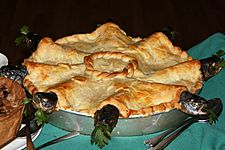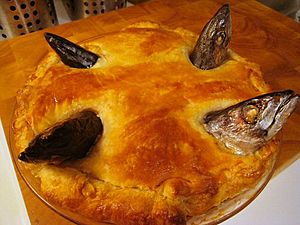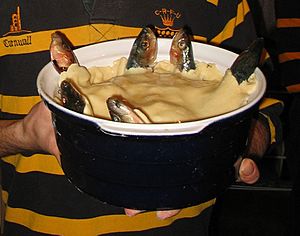Stargazy pie facts for kids

A stargazy pie, ready to serve
|
|
| Alternative names | Starrey gazey pie |
|---|---|
| Course | Main |
| Place of origin | Cornwall |
| Region or state | Cornwall |
| Serving temperature | Hot |
| Main ingredients | Pilchards |
Stargazy pie is a special Cornish dish from Cornwall, England. It's a type of fish pie made with baked pilchards (which are a kind of sardine), eggs, and potatoes, all covered with a pastry crust. What makes stargazy pie unique is that the heads (and sometimes tails) of the fish stick out through the crust. This makes them look like they are "gazing" up at the "stars"!
This interesting dish comes from the village of Mousehole in Cornwall. People traditionally eat it during a festival called Tom Bawcock's Eve. This festival celebrates a brave fisherman named Tom Bawcock. He made a huge catch of fish during a very stormy winter, which saved his village from starving. The story of Tom Bawcock and the pie became famous thanks to Antonia Barber's children's book, The Mousehole Cat.
Contents
What is Stargazy Pie?
Stargazy pie is a pastry-covered fish pie. It is usually filled with whole pilchards. The most important part is that the pilchards must keep their heads. These heads then poke through the top of the pastry. They look like they are staring up at the sky.
Having the fish heads stick out helps the oil from the fish drain into the pie while it cooks. This makes the pie taste richer and keeps it moist. Some chefs even suggest poking the fish tails through the crust too. This can make the fish look like they are leaping out of water.
Even though many people find the pie fun and amusing, it has also been called unusual. It is a traditional dish served in The Ship Inn, the only pub in Mousehole. This often happens after people act out the legend of Tom Bawcock.
The Story Behind the Pie
The stargazy pie comes from the fishing village of Mousehole in Cornwall. Like many old traditions, there is a special legend about how it started. The pie is eaten to celebrate the bravery of a local fisherman named Tom Bawcock. He lived in the 16th century.
The legend says that one winter was very stormy. Because of the bad weather, no fishing boats could leave the harbour. As Christmas got closer, the villagers, who ate a lot of fish, were starting to run out of food. They faced starvation.
On December 23, Tom Bawcock decided to be brave. He went out in his fishing boat despite the storms. Even with the difficult seas, he caught enough fish to feed everyone in the village. All the fish he caught (including seven different kinds) were baked into one big pie. The fish heads poked through the crust to show everyone that there was plenty of fish inside.
Since then, the Tom Bawcock's Eve festival is held every year on December 23 in Mousehole. During the celebration, villagers carry a huge stargazy pie in a parade. They also carry handmade lanterns. After the parade, they eat the pie to remember Tom Bawcock's efforts.
The festival has been part of the Mousehole village illuminations since 1963. During this time, the whole harbour is lit up with many lights. One set of lights even looks like the pie itself. It shows fish heads and tails sticking out of a pie dish, with six stars above.
How Stargazy Pie is Made
The original pie in the legend was said to include different types of fish. These included sand eels, horse mackerel, pilchards, herring, dogfish, and ling, plus a seventh kind of fish. In a traditional stargazy pie today, the main fish is the pilchard. However, mackerel or herring can also be used.
Some chefs say that any white fish can be used for the filling. Pilchards or herring are often added just for the special "stargazing" look. Before putting the fish in the pie, it is usually skinned and boned. This makes it easier to eat, but the head and tail are kept on. Besides the fish, other traditional ingredients are thickened milk, eggs, and boiled potatoes.
There are many ways to make stargazy pie. Some recipes add hard-boiled eggs, bacon, onion, mustard, or white wine. Instead of fish, some versions have crayfish, rabbit, or mutton. The pie always has a pastry lid. This is usually shortcrust, but sometimes puff pastry is used. The fish heads and sometimes tails stick out through this lid.
For a nice presentation, the pilchards can be arranged with their tails pointing to the center of the pie. Their heads then poke up through the crust around the edge. Since the pie has potatoes and pastry, it can be eaten on its own. It also goes well with crusty bread or vegetables. Some people like to serve it with Cornish Yarg cheese, rhubarb chutney, poached eggs, or a slice of lemon.
Stargazy Pie in Music
The unique pie has even inspired music!
- Nancy Kerr and James Fagan (musician) released an album and a song called Starry Gazy Pie in 1997.
- Jim Causley mentions "starry-gazey pie" in his song "My Young Man's a Cornishman." This song is from his 2013 album Cyprus Well. The lyrics come from a poem by his distant relative, Charles Causley (1917-2003).
See also
 In Spanish: Stargazy pie para niños
In Spanish: Stargazy pie para niños



